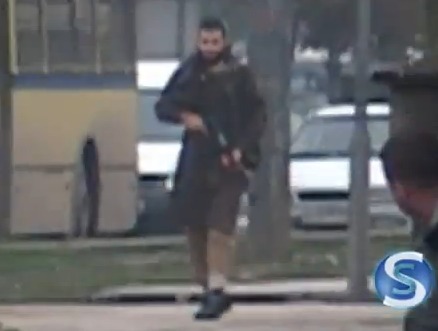Wahhabis in short pants
 I was writing a post about how we cover suspected or actual terrorism (which I'll save for tomorrow) when word came that a gunman fired shots at the United States Embassy in the Bosnian capital, Sarajevo. As snippets of news came out about this on Twitter, I saw a picture of the gunman (seen here) and it appeared, because the picture wasn't of great quality, that the man was wearing shorts. That seemed odd attire for a gunman in October. Sarah Schlesinger, a research fellow at the Center for Religious Freedom at Hudson Institute, explained:
I was writing a post about how we cover suspected or actual terrorism (which I'll save for tomorrow) when word came that a gunman fired shots at the United States Embassy in the Bosnian capital, Sarajevo. As snippets of news came out about this on Twitter, I saw a picture of the gunman (seen here) and it appeared, because the picture wasn't of great quality, that the man was wearing shorts. That seemed odd attire for a gunman in October. Sarah Schlesinger, a research fellow at the Center for Religious Freedom at Hudson Institute, explained:
"Short pants," which is used as a euphemism for Wahhabis in Bosnia.
You learn something every day. And, indeed, this man had the appearance of a Muslim from his facial hair. I wondered how the media would report this. Some readers complain that the media downplay the role of Islam whenever there's a terrorist incident. That certainly can be true, but it's also true that reporters are in the business of reporting things that can be confirmed, not speculated. Just because someone appears to be something doesn't mean you can begin extrapolating from there. We need to nail down what we know and what we don't know.
So having said that, I thought that this New York Times blog did a great job of reporting the news, with a concern for the religious angle.
The top of the story is a just-the-facts look at precisely what happened. Gunman fired shots at the Embassy. Video of the assault was posted by a news service. State Department guy says no injury reports. Embassy is in lockdown. Law enforcement is responding. A (yes, "A") Bosnian president condemns the attack. Another president (how many presidents does this country have?) called the incident a "terrorist attack." Some media outlets report that the gunman was wounded by a police sniper.
And then we get some information about a possible religion angle:
Citing a Sarajevo newspaper, the Belgrade radio station B-92 reported that there might have been more than one attacker, and noted that the man seen in the video was bearded in the manner of Islamist radicals.
The Sarajevo daily, Dnevni Avaz, reported in a live blog on the attack that the gunman was a 23-year-old with a Slavic name who was born in the Sandzak region of Serbia, which is home to a Muslim community. The newspaper also said that the man spent time in Gornja Moaca, an isolated village in northern Bosnian which was home to a small group of adherents of Wahabbism, a strict form of Islam.
This Bosnian television report on the shooting shows police officers outside the U.S. Embassy after the incident, and identifies the gunman as Mevlid Jašarevi?.
Most of Bosnia’s indigenous Muslim population is made up of ethnic Slavs, whose ancestors converted to Islam centuries ago, during Ottoman Turkish rule. Although the community as a whole has not been particularly observant in recent decades, from the start of the country’s civil war in the 1990s, Bosnian Muslims were subjected to a violent campaign of ethnic cleansing by extremists from the Serb Orthodox and Croat Catholic communities.
During the civil war, hundreds of Islamist foreign fighters came to the aid of the Bosnian Muslims. Some of those men remained in the country after the Dayton peace accords were signed in 1995.
Last year, Bosnian police officers raided Gornja Moaca where some former fighters of Arab origin were reported to have established a community that practiced a strict form of Islam.
I just wanted to highlight how the reporter included information that people must have been wondering about without going overboard or being too restrained. The report indicates what information is known and what information might be relevant. Perhaps facts that are revealed later will show that some of this context was insufficient, but it's a good start.